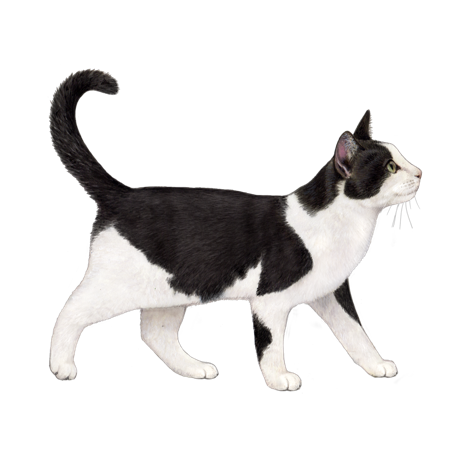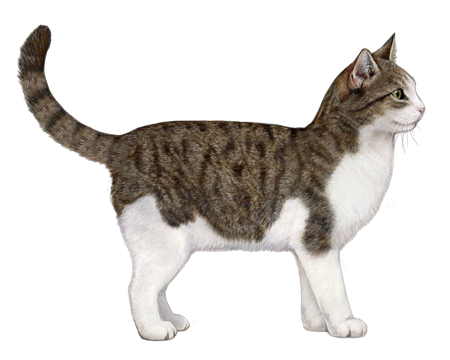
European Shorthair
European Shorthairs are intelligent, loyal, and playful cats that adapt well to most environments and situations. These qualities make them an excellent fit for young families, seniors, and everything in between.
Interested in discovering if your cat is an European Shorthair?
Check out Wisdom Panel's DNA test.
European Shorthair Traits
General Appearance
European Shorthairs are medium-to-large cats. They have a robust, muscular build with a well-developed chest and sturdy legs.
Coat and Colouring
The European Shorthair's coat—which comes in almost all colors and patterns—is glossy, dense, and close-lying, with little undercoat. Not included in the breed standard are the sepia, mink, and colorpoint patterns, as well as chocolate, lilac, cinnamon, and fawn.
Distinctive Physical Traits
European Shorthairs have slightly rounded skulls, well-developed cheeks, and tails that are thick at the base and taper to a rounded tip. Their ears are as tall as they are wide, with slightly rounded tips, and they can be tufted. The breed's medium-to-large round eyes come in green, amber, blue, or odd eye (one blue and one amber).
European Shorthair Temperament
European Shorthairs are adaptable and easily adjust to any environment. They are friendly cats that enjoy the company of other cats, people (including kids), and respectful dogs. But they can be a little shy around strangers and may initially hide until they feel it's safe to come out and socialize.
European Shorthairs maintain a playful, kitten-like attitude their whole lives. They're also a very intelligent breed. So, giving them food puzzles and interactive toys will help them stay both physically and mentally fit.
True to their roots, European Shorthairs will hunt small animals if given a chance. For this reason, you'll want to keep pocket pets—such as guinea pigs or hamsters—at a safe distance. If left outside, these natural hunters will also likely target mice and birds.
European Shorthair History
The European Shorthair is a direct descendant of ancient Rome's common domestic cat. This ancestor accompanied Roman soldiers to protect food supplies from rodents as they traveled across Europe. Known for their keen hunting skills, European Shorthairs played a critical role as vermin controllers and farm cats in early settlements.
The breed developed naturally for hundreds of years, unencumbered by breeding rules. It wasn't until the 20th century that Swedish breeders—hoping to preserve the cats' original Roman look—created the first breed standard.
The Federation Internationale Féline (FIFe) recognized the European Shorthair in 1992. No U.S. cat clubs currently recognize the breed. But it remains very popular in Scandinavia and is the national cat of Finland.
European Shorthair Care
Nutrition
European Shorthairs require a high-quality diet. Because nutritional needs vary for kittens, adults, and senior cats, opt for a formula that's age-appropriate for your pet.
To keep your cat at a healthy weight, monitor food intake and reduce portions if necessary. And be mindful of calories if you decide to give them human food as a treat. Just one small piece of cheese can account for half their recommended daily calories. As a guideline, treats should make up no more than 10% of a cat's daily intake.
Finally, every cat needs easy access to fresh, clean water at all times.
Grooming
European Shorthairs are skilled self-groomers. But they still need weekly brushing to keep their coats free of loose hair.
Regular nail trims will prevent your cat's claws from growing too long, snagging on something, and becoming torn or damaged. (Long nails can also grow into their paw pads, leading to pain or infection.) If you provide a scratching post, your kitty will likely do their own part to keep their nails healthy, thanks to their natural desire to scratch.
Good dental hygiene is essential to every cat's overall health. So, beginning in kittenhood, start your European Shorthair on a dental routine that includes at-home teeth brushing and professional exams and cleanings.
Health
Roughly one out of every three cats in the United States is overweight or obese. And those extra pounds can contribute to other health risks—such as arthritis, diabetes, and heart problems. Your veterinarian is the best resource for tips on keeping your cat at a healthy weight.
European Shorthair Genetic Health Conditions
-
Pyruvate Kinase Deficiency
Pyruvate Kinase (PK) Deficiency is a disorder that causes anemia due to the breakdown of red blood cells.
With more than 45 health tests, Wisdom Panel™ Complete for Cats screens for these and other important genetic conditions—allowing you to better plan for your cat's lifelong care.
Breed Group
Western
The largest of breed groups, the Western Group is mainly comprised of cats developed in Europe and the Americas. Due to the complexity of feline genetic diversity, however, cat breeds from other regions may also be found associated with this group.
Resources
http://m.loof.asso.fr/?fu=fiche_race&id=23
http://www1.fifeweb.org/dnld/std/EUR.pdf
https://www.banfield.com/state-of-pet-health/obesity
Reviewed 23 February 2021 by Jamie Freyer, DVM




































